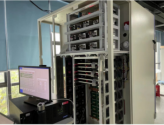Optimization of Dummy Poly-silicon removal in high-k metal gate process
Xiongfei.Wei, Wenjun.Wang, Xiaoyan.Zhang, Jian.Wang
ACM Research (Shanghai), Inc
According to Moore’s law, semiconductor technology nodes have shrunk to less than 45nm in the last decades. High-K meta gate process is widely used at nodes of 28nm and below, because of low power consumption and lower leakage In gate first high-k metal gate process, there is a need to remove dummy grid polysilicon by wet etch and stop on work function metal (WFM) or hafnium oxide (HfO2) after source and drain ion implantation and thermal annealing processes. The wet etch solutions need to be selected to remove dummy poly-silicon and WFM, but solutions need to be selective, so not to etch grid sidewall silicon oxide. Ammonia etches poly-silicon faster than etching of silicon oxide or titanium nitride (TiN). Some WFM such as titanium nitride can be etched by solutions containing hydrogen peroxide, but HfO2 cannot be etched. During dummy poly-silicon removal process in a single cleaning tool, the use of high temperature and concentrated etch solutions can cause a problem. When a high temperature solution sprays onto the center of a wafer, there is a high temperature variation which will create a disparity in the etching rate from center to the edge of wafer, this temperature variation will create an etch difference from center to edge. Optimizing the etch uniformity is very important to the dummy poly-silicon removal process. In this paper, we confirm that a diluted ammonia mixture (ADM) and SC1 etch capability on polysilicon, thermal oxide and titanium nitride. Based on film etching experiment results, we carried out a high-k loop film etching experiment. Figure.1 shows TEM result of original waferwithout any processing, ADM treated wafer and ADM+SC1 treated wafer. Original wafer is deposited HfO2, WFM, poly-silicon films. ADM etch stop on WFM and ADM+SC1 etch stop on HfO2. So we can effectively control the dummy poly silicon removal process by combining ADM and SC1 etching solutions.
View attachment 114022


